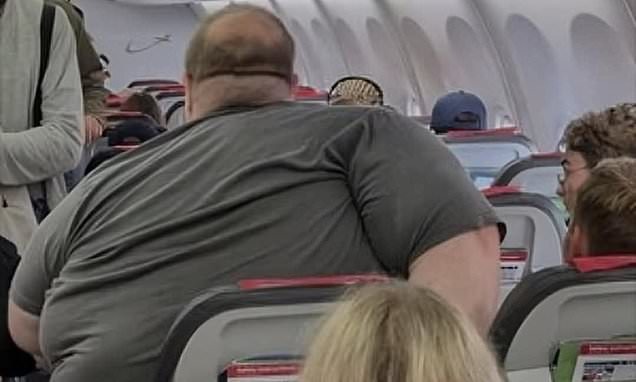
Flying has long been considered a convenient way to travel long distances—but for many passengers, it comes with challenges. From cramped seating to limited legroom, air travel often leaves passengers feeling uncomfortable and frustrated. Recently, a viral photo shared on social media reignited an intense discussion around airline seating policies, particularly regarding accommodations for plus-sized travelers.
The Photo That Captured Global Attention
The incident began when Pretty Ricky, a Miami-based hip-hop musician famous for the early 2000s hit “Grind with Me,” posted a photo from a flight between Helsinki and Copenhagen.
The image depicted a visibly plus-sized passenger struggling to fit into a standard airplane seat. It was an image that resonated with many—either through personal experiences or broader concerns about fairness and dignity during air travel.
The post quickly spread across social media, gaining thousands of shares and comments within hours. According to the Daily Mail, the photo stirred intense debate, shining a spotlight once again on the long-standing issue of whether airlines are doing enough to accommodate the diverse needs of their passengers.
In their public statement accompanying the image, Pretty Ricky’s group expressed solidarity with the passenger:
“Airlines need to implement measures for plus-sized travelers. This recent photo highlights the challenges faced by passengers who require more than one seat, as well as the discomfort for nearby travelers. It’s a complex issue that needs a balanced solution.”
Their post triggered an avalanche of public reaction—revealing just how complicated and emotionally charged the issue has become.
How Airlines Currently Handle Plus-Sized Passengers

While there is no universal airline policy regarding seating accommodations for plus-sized passengers, many major carriers have existing (though often unclear) procedures:
-
Some airlines, like Southwest Airlines, offer a “Customer of Size” policy where passengers who cannot fit safely and comfortably in a single seat must purchase an additional seat but can request a refund after the flight.
-
Others, like United Airlines and American Airlines, encourage customers to purchase a second seat in advance if they anticipate needing more room.
-
In certain cases, passengers may request assistance discreetly at the airport if they realize the need for extra space at check-in.
However, critics argue that such policies are inconsistently applied, poorly communicated, and sometimes handled insensitively—leading to embarrassment, confusion, and dissatisfaction for passengers.
Additionally, the industry standard for economy class seats—roughly 17-18 inches wide—has remained relatively unchanged, even as the average body size of travelers has increased over the decades.
Public Reaction: Divided but Passionate

The debate online mirrored larger societal conversations about inclusion, personal responsibility, and corporate accountability.
Some commenters expressed empathy, agreeing that airlines should provide better accommodations:
-
“Everyone deserves to fly with dignity. Airlines should design seating with real people in mind, not just maximize profit,” one user wrote.
-
“The world is diverse—planes should reflect that. No one should feel ashamed of needing extra space,” another said.
Others, however, emphasized the practical and financial realities of running an airline:
-
“If someone occupies two seats, they ought to pay for both. It’s not fair to the airline or other passengers,” a commenter stated.
-
“Weighing passengers like luggage sounds harsh, but space and weight are real safety concerns,” another added.
A third group took a broader view, pointing out that everyone—regardless of size—suffers from increasingly cramped airline seating:
-
“Airline seats are too small for even slim people. Instead of targeting plus-size travelers, we should push airlines to offer more humane space for everyone!”
Clearly, the issue touches on deeper societal values: fairness, compassion, accessibility, and economic pragmatism.
Industry Pressures and the Economics of Airline Seating

To understand the complexities involved, it’s important to recognize the economic pressures airlines face.
Over the past two decades, most airlines have reduced seat pitch (the distance between a seat and the one in front of it) from about 34 inches to closer to 28-31 inches in economy class, allowing more seats per plane—and thus more profit per flight.
Wider seats or fewer seats mean higher operating costs, which would likely lead to higher ticket prices for all travelers.
As a result, airlines often balance customer satisfaction against financial viability, sometimes sacrificing comfort in the process.
However, critics argue that focusing solely on maximizing revenue overlooks basic human dignity—and that offering different seating options (at different price points) could be a workable solution without punishing either plus-sized travelers or the airlines’ bottom line.
Potential Solutions Under Discussion
Several ideas have been proposed to address the concerns highlighted by the viral photo:
-
Offer Wider Seats
Some airlines already offer “premium economy” seats that are slightly wider and have more legroom. Expanding this class—and making it more accessible and affordable—could help accommodate a greater diversity of body types. -
Flexible Seating Options
Airlines could implement flexible seating policies that allow passengers to select adjoining seats at discounted rates if needed, without stigmatization. -
Clear Communication
Better communication at the time of booking—such as listing seat dimensions prominently—could help travelers plan ahead more comfortably. -
Redesigning Cabin Layouts
Some have proposed rethinking airplane interiors altogether, offering varied seating sizes and configurations to fit different needs, similar to how trains or buses provide accessible spaces. -
Weight and Balance Considerations
Though controversial, industry experts note that overall aircraft weight must be carefully managed for safety. Airlines could offer voluntary weight and size declarations at booking—not as a punitive measure, but to ensure safe and comfortable travel arrangements.
A Broader Conversation About Inclusivity
At its core, the viral photo reflects a broader cultural shift: a growing demand for businesses—especially those offering essential services like travel—to design their experiences around real, diverse human needs.
The conversation is about dignity, comfort, and respect, not just about logistics. Whether it involves passengers with disabilities, families with small children, seniors with mobility challenges, or plus-sized individuals, the expectation is clear: people want inclusivity, without shame or discrimination.
Conclusion: A Challenge and an Opportunity for Airlines
The viral discussion sparked by Pretty Ricky’s post has made one thing clear:
Airlines can no longer afford to ignore conversations about comfort and accessibility.
While there’s no easy solution, there is a growing opportunity for airlines willing to lead the way in creating more humane, inclusive travel experiences.
As cabin designs evolve and public expectations shift, airlines that listen—and respond with compassion and practicality—will likely win customer loyalty in a competitive industry.
For now, passengers and airlines alike continue navigating the complexities of air travel, seeking a future where everyone—no matter their size or circumstance—can fly with dignity.



